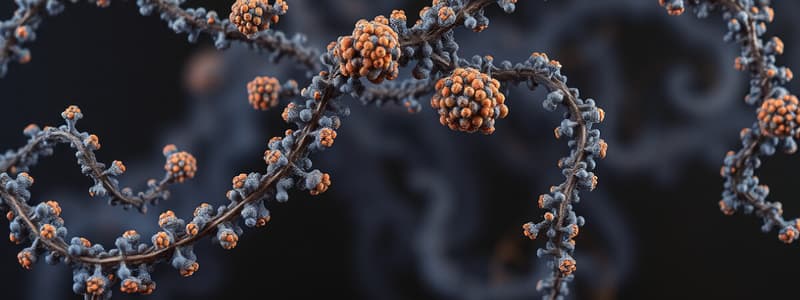Podcast
Questions and Answers
What is the ultimate destination for non-coding RNAs?
What is the ultimate destination for non-coding RNAs?
- Not a protein (correct)
- Cellular repair
- Energy production
- Protein synthesis
All eukaryotic genes are encoded by RNA.
All eukaryotic genes are encoded by RNA.
False (B)
Name two examples of non-coding RNAs.
Name two examples of non-coding RNAs.
tRNAs and rRNAs
Human genes transcribed into non-coding RNAs may equal or even exceed the number of __________ genes.
Human genes transcribed into non-coding RNAs may equal or even exceed the number of __________ genes.
Match the following types of RNA with their characteristics:
Match the following types of RNA with their characteristics:
Which of the following statements is true regarding non-coding RNAs?
Which of the following statements is true regarding non-coding RNAs?
The term 'non-coding RNAs' can be shortened to 'ncRNAs'.
The term 'non-coding RNAs' can be shortened to 'ncRNAs'.
What percentage of human genes are estimated to be non-protein-coding?
What percentage of human genes are estimated to be non-protein-coding?
How much of the genome is considered active?
How much of the genome is considered active?
Noncoding RNAs are translated into proteins.
Noncoding RNAs are translated into proteins.
What is the transcriptome?
What is the transcriptome?
The ______ project has shown that most of the non-coding DNA has a purpose.
The ______ project has shown that most of the non-coding DNA has a purpose.
Which of the following statements about noncoding RNAs is false?
Which of the following statements about noncoding RNAs is false?
Match the following types of non-coding RNAs with their descriptions:
Match the following types of non-coding RNAs with their descriptions:
What does qPCR stand for?
What does qPCR stand for?
Microarrays can measure gene expression for thousands of genes at a time.
Microarrays can measure gene expression for thousands of genes at a time.
What is transcriptomics?
What is transcriptomics?
High throughput RNA ________ allows for sequencing of all transcripts without limits.
High throughput RNA ________ allows for sequencing of all transcripts without limits.
Which of the following is a limitation of qPCR?
Which of the following is a limitation of qPCR?
Match the following techniques with their key features:
Match the following techniques with their key features:
Transcriptomics is limited to a known number of genes.
Transcriptomics is limited to a known number of genes.
Microarrays focus primarily on _______ coding genes.
Microarrays focus primarily on _______ coding genes.
What is the purpose of using fluorescently labelled dNTPs in sequencing by synthesis?
What is the purpose of using fluorescently labelled dNTPs in sequencing by synthesis?
RNA-seq is less effective at quantifying highly expressed genes compared to microarrays.
RNA-seq is less effective at quantifying highly expressed genes compared to microarrays.
Explain one advantage of RNA-seq over microarrays.
Explain one advantage of RNA-seq over microarrays.
A primer anneals to the linker at the end of the cDNA fragment attached to the __________.
A primer anneals to the linker at the end of the cDNA fragment attached to the __________.
Match the following RNA-seq advantages with their descriptions:
Match the following RNA-seq advantages with their descriptions:
What happens when the correct dNTP is incorporated during sequencing by synthesis?
What happens when the correct dNTP is incorporated during sequencing by synthesis?
The chain-terminating modification of dNTPs in sequencing by synthesis cannot be reversed.
The chain-terminating modification of dNTPs in sequencing by synthesis cannot be reversed.
What is a challenge of working with RNA samples?
What is a challenge of working with RNA samples?
What is the main purpose of RNA-sequencing?
What is the main purpose of RNA-sequencing?
RNA-seq can provide sequence level information that microarrays cannot.
RNA-seq can provide sequence level information that microarrays cannot.
What format are RNA-sequencing outputs typically in?
What format are RNA-sequencing outputs typically in?
RNA-sequencing can yield up to ______ million reads.
RNA-sequencing can yield up to ______ million reads.
Match the following terms with their descriptions:
Match the following terms with their descriptions:
Which of the following is an advantage of RNA-seq over microarrays?
Which of the following is an advantage of RNA-seq over microarrays?
Short sequence reads from RNA-seq are typically 150-200 bp long.
Short sequence reads from RNA-seq are typically 150-200 bp long.
What is the minimum length of short sequence reads in RNA-seq?
What is the minimum length of short sequence reads in RNA-seq?
Study Notes
Non-Coding RNAs
- Human genes transcribed into non-protein-coding RNAs may equal or exceed protein-coding genes.
- Non-coding RNAs include tRNAs, rRNAs, miRNAs, and lncRNAs.
- All eukaryotic genes are encoded by DNA; non-coding RNAs are not translated into proteins.
- Previously considered "junk DNA," non-coding DNA has known functions as demonstrated by the ENCODE project.
Transcriptomics
- Transcriptomics studies gene expression by quantifying all RNAs in a specific cell or tissue at a given time.
- Unlike earlier methods, RNA-seq provides a comprehensive analysis without prior gene knowledge.
High Throughput Sequencing
- RNA-seq uses high throughput sequencing to analyze RNA from cells or tissues.
- Sequencing by synthesis involves primer annealing, polymerase extension, and fluorescent labeling of dNTPs.
Advantages of RNA-seq
- RNA-seq identifies approximately 40% more transcripts than microarrays and quantifies low and high expressed genes effectively.
- Can detect alternative splicing, novel exons, and mutations in transcripts.
- Provides a highly sensitive and dynamic range of data.
Challenges in RNA Transcriptome Studies
- RNA samples are fragile and can be unstable, impacting data accuracy and reliability.
- Highly expressed RNAs may dominate sequencing resources, limiting analysis of less abundant transcripts.
RNA-sequencing Process
- The RNA-seq process includes three main steps: library preparation, clonal amplification, and sequencing.
- A fastq format is utilized for storing sequencing data, containing millions of short sequence reads.
Key Takeaways from Part 2 Summary
- RNA-sequencing offers an unbiased quantitative survey of transcripts, including novel RNA detection.
- Compared to microarrays, RNA-seq provides more detailed sequence-level information.
Studying That Suits You
Use AI to generate personalized quizzes and flashcards to suit your learning preferences.
Related Documents
Description
Explore the fascinating world of non-coding RNAs and transcriptomics in this quiz. Learn about the roles of different non-coding RNAs, the advancements in RNA-seq technology, and the advantages it holds over traditional methods. Test your understanding of how these elements contribute to gene expression studies.




